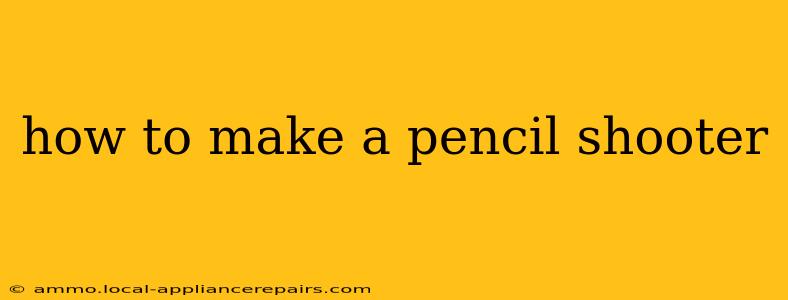Want to build a fun and surprisingly accurate pencil shooter? This guide will walk you through the process, from gathering materials to mastering the launch technique. We’ll explore different designs, safety considerations, and tips for improving your shooting accuracy. Get ready to unleash your inner engineer!
Materials You'll Need:
The beauty of a pencil shooter is its simplicity. You likely already have most of the materials at home. Here's what you'll need for a basic design:
- Two Rubber Bands: Thick, sturdy rubber bands work best. Avoid flimsy ones that will break easily.
- Two Pencils: Standard #2 pencils are ideal, but you can experiment with different sizes and types.
- Scissors: For trimming the rubber bands if necessary.
- Optional: Tape (masking or duct tape): For added stability and to secure the rubber bands.
Building Your Pencil Shooter: A Simple Design
This design is easy to assemble and provides a good starting point for understanding the mechanics:
- Prepare the Rubber Bands: Stretch one rubber band and carefully loop it around the eraser end of one pencil. Ensure the loop is secure.
- Attach the Second Rubber Band: Take the second rubber band and carefully loop it around the sharpened end of the same pencil. The two rubber bands should now be stretched and create a "sling" around your pencil.
- Create the Launcher: Take the second pencil and place it into the center of the stretched rubber bands, between the loops. This will be your projectile launcher.
- Loading the Projectile: Place another pencil (the projectile) into the open end created by the stretched rubber bands.
- Launching the Pencil: Hold the first pencil firmly, aiming it in your desired direction. Quickly and smoothly release your grip on the first pencil. The stored energy in the rubber bands will propel the second pencil forward.
Advanced Designs and Modifications:
Once you've mastered the basic design, you can experiment with different variations:
- Multiple Rubber Bands: Using more rubber bands increases the power of the launch, but also makes aiming more challenging.
- Different Pencil Types: Experiment with different pencil sizes and weights to see how they affect the range and accuracy of your shooter.
- Added Stability: Use tape to reinforce the rubber band loops or create a more stable grip for the launcher pencil.
- Customizing the Launcher: Create a more sophisticated launcher using craft materials, such as cardboard or wood, to improve accuracy and control.
Safety First!
- Always aim away from people and fragile objects. Pencil shooters, while fun, can still cause injury or damage if mishandled.
- Use caution when handling scissors. Adult supervision is recommended for younger children.
- Avoid using overly powerful rubber bands, as this can lead to uncontrolled launches and potential dangers.
- Never point the pencil shooter at your eyes or face.
Tips for Improving Accuracy:
- Consistent Launch Technique: Practice a smooth, consistent release to improve accuracy.
- Experiment with Grip: Find the most comfortable and stable grip for your launcher pencil.
- Adjust Rubber Band Tension: Experiment with the amount of stretch on the rubber bands to fine-tune the power and range of your launch.
- Practice Makes Perfect: The more you practice, the better you'll become at aiming and controlling the trajectory of your projectile.
Conclusion:
Building a pencil shooter is a fun and engaging activity that combines creativity and physics. Remember to prioritize safety and experiment with different designs to find what works best for you. Now go forth and unleash your inner sharpshooter!

